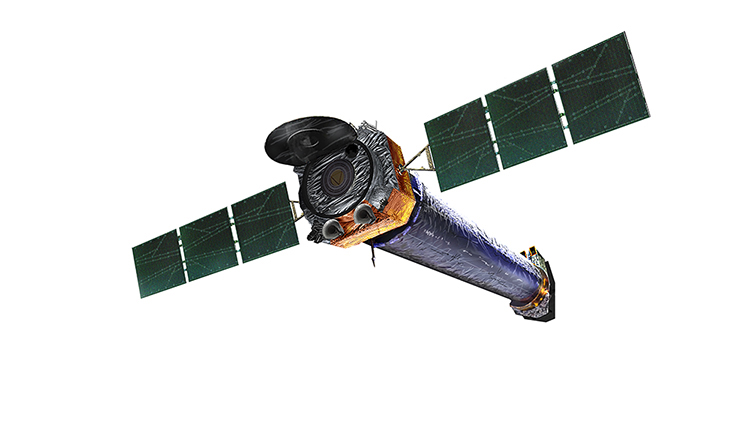 NASA's Chandra X-ray Observatory is a telescope specially designed to detect X-ray emission from very hot regions of the Universe such as exploded stars, clusters of galaxies, and matter around black holes. Because X-rays are absorbed by Earth's atmosphere, Chandra must orbit above it, up to an altitude of 139,000 km (86,500 mi) in space.
NASA's Chandra X-ray Observatory is a telescope specially designed to detect X-ray emission from very hot regions of the Universe such as exploded stars, clusters of galaxies, and matter around black holes. Because X-rays are absorbed by Earth's atmosphere, Chandra must orbit above it, up to an altitude of 139,000 km (86,500 mi) in space.
Chandra is known for its beautiful photographs of the Planets, Galaxies and Star Clusters all of which are available openly for free, some of which are also at high resolution
-
The Telescope
The Chandra telescope system consists of four pairs of mirrors and their support structure.

X-ray telescopes must be very different from optical telescopes. Because of their high-energy, X-ray photons penetrate into a mirror in much the same way that bullets slam into a wall. Likewise, just as bullets ricochet when they hit a wall at a grazing angle, so too will X-rays ricochet off mirrors.
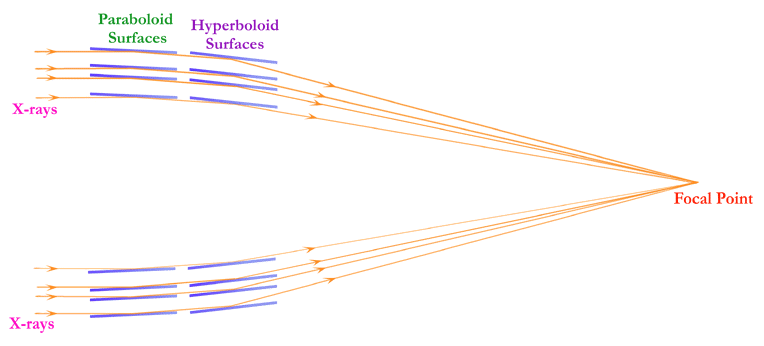 The mirrors have to be exquisitely shaped and aligned nearly parallel to incoming X-rays. Thus they look more like glass barrels than the familiar dish shape of optical telescopes.
The mirrors have to be exquisitely shaped and aligned nearly parallel to incoming X-rays. Thus they look more like glass barrels than the familiar dish shape of optical telescopes.
Imagine making the surface of the Earth so smooth that the highest mountain was less than two meters (78 inches) tall! On a much smaller scale, the scientists and engineers at Raytheon Optical Systems in Danbury, Connecticut accomplished an equivalent feat when they polished and ground the four pairs of Chandra mirrors to the smoothness of a few atoms.
Not to be outdone, the scientists and engineers at Optical Coating Laboratories, Inc., in Santa Rosa, California also surpassed expectations. After the mirrors were carefully moved to California via an air-ride moving van, they were painstakingly cleaned--to the equivalent of at most one speck of dust on an area the size of your computer screen. Then they were coated with the highly reflective rare metal, iridium.
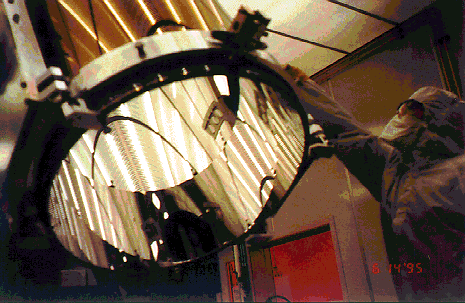
The successful grinding, polishing and coating of the Chandra mirrors were historic technical accomplishments. They are the smoothest and cleanest mirrors ever made.
The mirrors were moved again across the country--same moving van, same husband/wife driving team and three support vehicles--to Eastman Kodak Company in Rochester, New York, where they were assembled into a support structure called the high resolution mirror assembly and aligned with exquisite precision. The alignment of the mirrors from one end of the mirror assembly to the other (2.7 meters or 9 feet) is accurate to 1.3 micrometers (50 millionths of an inch) or about one fiftieth the width of a human hair! The successful completion of the high resolution mirror assembly at Eastman Kodak in September 1996, was one of the major accomplishments in the development of Chandra.
-
The Spacecraft
Motion, Heat, and Energy
The spacecraft system provides the support structure and environment necessary for the telescope and the science instruments to work as an observatory.
In order to provide motion to the observatory, Chandra has two different sets of thrusters: one for propulsion and the other for momentum unloading. The propulsion thrusters were used immediately after launch to help propel Chandra into its final orbit, which is elliptical and very high in altitude. The momentum unloading thrusters are periodically used to apply torques to Chandra and, thereby, lower the accumulated momentum in its reaction wheels, which are used to control Chandra's altitude.
To control the temperatures of critical components, Chandra's thermal control system consists of a cooling radiator, insulators, heaters, and thermostats. It is particularly important that the temperature near the X-ray mirrors be well controlled to keep the mirror in focus. The temperature in many parts of the spacecraft is continually monitored and reported back to mission control.
There is no single operating temperature of Chandra, as there is a lot of variation. One of the coldest parts of the spacecraft is the Advanced CCD Imaging Spectrometer (ACIS) focal plane which is regulated at -120 C. It gets passively cooled by the ACIS radiator which faces straight out into cold space and is even colder than -120 C. The High Resolution Mirror Assembly (HRMA) is held at a very stable temperature and is a balmy 71 F to within about 1 degree F. Other parts of the spacecraft have wild temperature swings, for instance the Fine Sun Sensor (which is mounted on the sun-facing exterior of the spacecraft) goes from around 30 F to almost 200 F, sometimes in the space of a few hours!
Chandra's electrical power comes from its solar arrays. This energy is then stored in three banks of batteries and distributed in a carefully regulated manner to the Observatory by the electrical power system. The solar arrays generate approximately two kilowatts of power for the heaters, science instruments, computers, transmitters, etc.
Locking On and Staying Steady
Located at the front of the spacecraft where radiation enters the telescope, the Sunshade door is one of the most basic and important elements of the spacecraft system. The Sunshade door remained closed until Chandra achieved pointing control in orbit. Now that it is opened, it shadows the entrance of the telescope to allow it to point as close as 45 degrees to the Sun.
The pointing control and aspect of determination system has gyros, an aspect camera, Earth and Sun sensors, and reaction wheels to monitor and control to very high accuracy where the telescope is pointing at any given moment. It is as if you could locate the bulls-eye on a target one kilometer (0.6 miles) away to the precision of three millimeters — about the size of a pinhead. This system can also put the Observatory into various levels of inactive, quiet states known as "safe modes" of operation during emergencies.
-
What's On-board?
The Chandra X-Ray Observatory combines the mirrors with four science instruments to capture and probe the X-rays from astronomical sources. The incoming X-rays are focused by the mirrors to a tiny spot (about half as wide as a human hair) on the focal plane, about 30 feet away. The focal plane science instruments, ACIS and HRC, are well matched to capture the sharp images formed by the mirrors and to provide information about the incoming X-rays: their number, position, energy and time of arrival.
Two additional science instruments provide detailed information about the X-ray energy, the LETG and HETG spectrometers. These are grating arrays which can be flipped into the path of the X-rays just behind the mirrors, where they redirect ( diffract ) the X-rays according to their energy. The X-ray position is measured by HRC or ACIS, so that the exact energy can be determined. The science instruments have complementary capabilities to record and analyze X-ray images of celestial objects and probe their physical conditions with unprecedented accuracy.
High Resolution Camera (HRC)
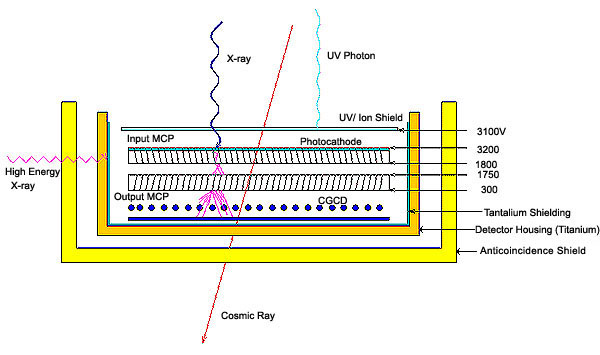 The High Resolution Camera (HRC) is one of two instruments used at the focus of Chandra, where it detects X-rays reflected from an assembly of eight mirrors. The unique capabilities of the (HRC) stem from the close match of its imaging capability to the focusing power of the mirrors. When used with the Chandra mirrors, the (HRC) can make images that reveal detail as small as one-half an arc second. This is equivalent to the ability to read a newspaper at a distance of half a mile.
The High Resolution Camera (HRC) is one of two instruments used at the focus of Chandra, where it detects X-rays reflected from an assembly of eight mirrors. The unique capabilities of the (HRC) stem from the close match of its imaging capability to the focusing power of the mirrors. When used with the Chandra mirrors, the (HRC) can make images that reveal detail as small as one-half an arc second. This is equivalent to the ability to read a newspaper at a distance of half a mile.The primary components of the (HRC) are two Micro-Channel Plates (MCP). They each consist of a 10-cm (4-inch) square cluster of 69 million tiny lead-oxide glass tubes that are about 10 micrometers in diameter (1/8 the thickness of a human hair) and 1.2 millimeters (1/20 an inch) long. The tubes have a special coating that causes electrons to be released when the tubes are struck by X-rays. These electrons are accelerated down the tube by a high voltage, releasing more electrons as they bounce off the sides of the tube. By the time they leave the end of the tube, they have created a cloud of thirty million electrons. A crossed grid of wires detects this electronic signal and allows the position of the original X-ray to be determined with high precision. With this information astronomers can construct a finely detailed map of a cosmic X-ray source. The (HRC) is especially useful for imaging hot matter in remnants of exploded stars, and in distant galaxies and clusters of galaxies, and for identifying very faint sources.
Advanced CCD Imaging Spectrometer (ACIS)
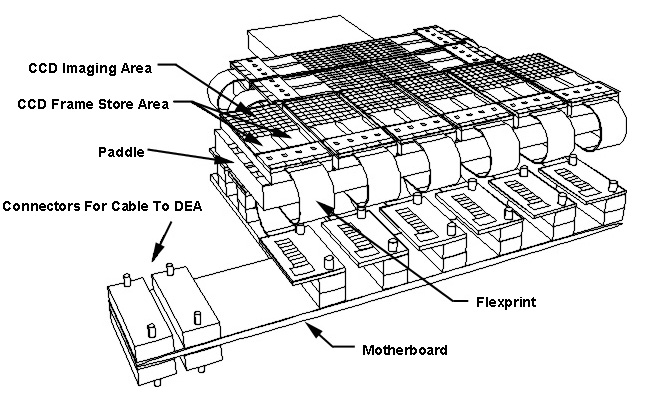 The Chandra Advanced CCD Imaging Spectrometer (ACIS) is one of two focal plane instruments. As the name suggests, this instrument is an array of charged coupled devices (CCD's), which are sophisticated versions of the crude CCD's used in camcorders. This instrument is especially useful because it can make X-ray images, and at the same time, measure the energy of each incoming X-ray. Thus scientists can make pictures of objects using only X-rays produced by a single chemical element, and so compare (for example) the appearance of a supernova remnant in light produced by oxygen ions to that of neon or iron ions. It is the instrument of choice for studying temperature variations across X-ray sources such as vast clouds of hot gas in intergalactic space, or chemical variations across clouds left by supernova explosions.
The Chandra Advanced CCD Imaging Spectrometer (ACIS) is one of two focal plane instruments. As the name suggests, this instrument is an array of charged coupled devices (CCD's), which are sophisticated versions of the crude CCD's used in camcorders. This instrument is especially useful because it can make X-ray images, and at the same time, measure the energy of each incoming X-ray. Thus scientists can make pictures of objects using only X-rays produced by a single chemical element, and so compare (for example) the appearance of a supernova remnant in light produced by oxygen ions to that of neon or iron ions. It is the instrument of choice for studying temperature variations across X-ray sources such as vast clouds of hot gas in intergalactic space, or chemical variations across clouds left by supernova explosions.The High Resolution Spectrometers - HETGS and LETGS
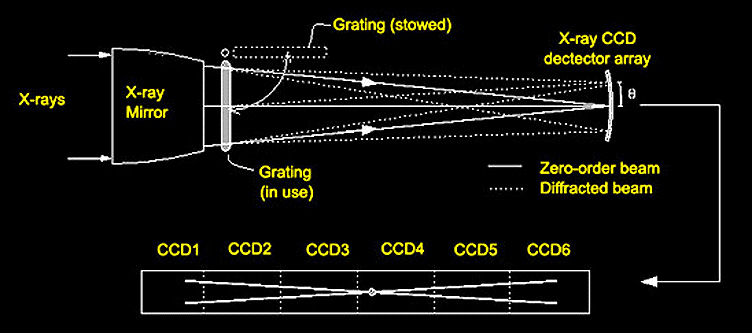 There are two instruments aboard Chandra dedicated to high resolution spectroscopy: the High Energy Transmission Grating Spectrometer (HETGS) and the Low Energy Transmission Grating Spectrometer (LETGS). Each spectrometer is activated by swinging an assembly into position behind the mirrors. The assembly holds hundreds of gold transmission gratings: when in place behind the mirrors, the gratings intercept the X-rays reflected from the mirrors.
There are two instruments aboard Chandra dedicated to high resolution spectroscopy: the High Energy Transmission Grating Spectrometer (HETGS) and the Low Energy Transmission Grating Spectrometer (LETGS). Each spectrometer is activated by swinging an assembly into position behind the mirrors. The assembly holds hundreds of gold transmission gratings: when in place behind the mirrors, the gratings intercept the X-rays reflected from the mirrors.These gratings diffract the intercepted X-rays, changing their direction by amounts that depend sensitively on the X-ray energy, much like a prism separates light into its component colors. One of the focal plane cameras, either HRC or ACIS, detects the location of the diffracted X-ray, enabling a precise determination of its energy. (A grating is able to diffract because it has a regularly spaced pattern. For example, music CDs act as a type of grating: the grooves diffract, so that when light falls on the shiny side of the CD, a rainbow effect is seen. As the CD is tilted through different angles, different colors come into view.)
The gratings exploit Chandra's sharp mirror focus and matching detector resolution to produce high resolution X-ray spectroscopy. Since the grating spectrometers can measure energy to an accuracy of up to one part in a thousand, they are used in the study of detailed energy spectra, distinguishing individual X-ray lines. This enables the temperature, ionization and chemical composition to be explored.
 The LETG grating is a freestanding gold grating made of fine wires or bars with a regular spacing, or period , of 1µm. The fine gold wires are held by two different support structures, a linear grid with 25.4µm and a coarse triangular mesh with 2 mm spacing. The gratings are mounted onto a toroidal ring structure matched to the Chandra mirrors. The LETG gratings are designed to cover an energy range of 0.08 to 2 keV. However, their diffraction can also be seen in visible light, which is beautifully shown in the picture above right.
The LETG grating is a freestanding gold grating made of fine wires or bars with a regular spacing, or period , of 1µm. The fine gold wires are held by two different support structures, a linear grid with 25.4µm and a coarse triangular mesh with 2 mm spacing. The gratings are mounted onto a toroidal ring structure matched to the Chandra mirrors. The LETG gratings are designed to cover an energy range of 0.08 to 2 keV. However, their diffraction can also be seen in visible light, which is beautifully shown in the picture above right.The HETG gratings have a much finer period, 0.2µm or 2000Å for the high-energy gratings, and 0.4µm or 4000Å, for the medium energy gratings. In order to distinguish between them, the two types of gratings are oriented at slightly different angles, so that the X-rays are diffracted in an "X" pattern at the focal plane. Since the size of the gold grating bars is smaller that a wavelength of visible light, special fabrication techniques are required to make them. The gratings take advantage of the fact that the gold bars are partially transparent to X-rays, so that the diffraction is more efficient, and more X-rays are captured in the high resolution spectrum. The HETG gratings are designed to cover an energy range of 0.4 to 10 keV.
-
Chandra Links
-
Tweets from Chandra
